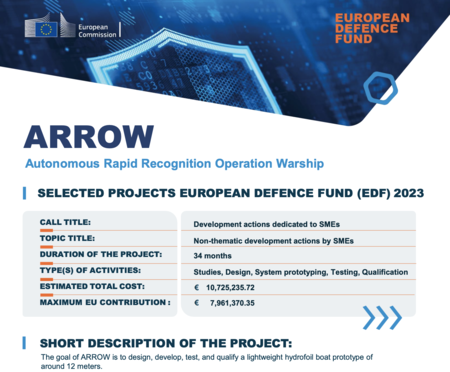Thousands of kilometers of coastline, a large number of strategic trade routes and a sea where threats are no longer announced with ships, but with drones, sabotages and undercover operations. Europe has begun to rearm, but not only with fighters or frigates: also with light, autonomous systems designed to act where radars do not arrive. Arrow is one of them. And he wants to become the new sentinel of the sea.
A European system for an increasingly hostile environment. Suicide drones cross the Red Sea. Corted submarine cables, blocked GPS, sabotages without signature. The war has entered the sea, but it has done so in silence. Europe has understood: large ships are no longer enough. Discrete surveillance is needed, agile systems, technology that detects before it is late.
What is Arrow and what makes it different. Imagine a ship that does not need a pilot, which barely generates noise and that could, in the near future, travel 740 km of coast without reposting. Imagine that, in addition, it is fast, stealthy and capable of acting autonomously. That is the Vision Arrow.
The project, officially launched in July 2025, seeks to develop a European Naval 12 meters of length with hydroalas, capable of operating autonomously or manned. It is still in the design and planning phase, with a prototype planned around 2027 and validation between that year and 2028. The idea is that it reaches up to 45 speed knots, minimize fuel consumption by 50% and reduce the acoustic and visual trail. Its final purpose is not to face great threats, but to detect what others do not see and alert in advance.

Arrow does not replace a patrol or a satellite. It aims to complement existing capabilities with an agile platform that combines discretion, artificial intelligence and operational efficiency: a tool designed to anticipate, not to attack.
What will Arrow be and what makes it possible. The first thing that attracts attention is its form: elongated, stylized, designed to cut the water without generating noise or turbulence. Arrow does not float: plans on the sea thanks to a retractable hydroalas system that allows you to reach up to 45 knots (about 83 kilometers per hour) and reduce consumption by half.
A system that does not need a pilot. What differentiates Arrow from a conventional unmanned boat is not only its speed or its design, but its brain. It is expected to incorporate autonomous navigation systems with embarked intelligence capable of processing data in real time. That will allow you to detect obstacles, adjust routes, dodge interference and maintain communications without constantly depending on a human operator.
This autonomy is key to acting in difficult or degraded environments, where the GPS signal can fail, be exposed to hackeos such as those suffering from airplanes or response time must be immediate. Instead of reacting from Earth, Arrow will make decisions in the water.
Who is behind the Arrow Project. The Arrow Project is managed by the European Defense Agency and has an estimated total cost of 10.7 million euros, of which the European Union will contribute almost 8 million through the European Defense Fund. The French company Seair coordinates a European consortium composed of ten organizations from eight member states or countries associated with the EU.
The consortium groups eight technological SMEs and two research organizations, among which are:
- Seair (France)
- Maritime Robotics (Norway)
- D3 Applied Technologies (España)
- Knierim Yachtbau (Germany)
- Sierra Tango (Belgium)
- Maxwell Applied Tech (España)
- C&C Defence (Bélgica)
- EU3Star BV (Netherlands)
- TalTech – Tallinn University of Technology (Estonia)
- Riga Technical University (Letonia)
The objective: unite industrial and scientific capacities to create a European, autonomous and exportable solution.
Arrow is not an isolated case: it is part of something bigger. The development of Arrow does not respond only to a technical need. It is part of a strategic turn: the European Union wants to have its own tools to defend their interests without depending on the pentagon. He is doing it with fighters (FCAS), with satellites (IRIS2), with air defense systems (Sky Shield), and now also with naval drones like this.

What is expected now. What today is a project on paper, within approximately three years could patrol the coasts of Europe. That is the plan. Arrow will have about 34 months of development ahead to move from design to reality. Throughout that time, the consortium must close the technical architecture, build a functional prototype and submit it to tests in real conditions.
As we say, the first great milestone will arrive in 2027, with the demonstrations in the open sea. If everything progresses as planned, the system could be ready for real operations in 2028.
At the moment no official images of Arrow’s final design have been disseminated. However, during the presentation of the project, the Naval News News had access to a physical model and was able to take several photographs of the act, including a partial image of the exposed model. These snapshots allow a first idea of the general lines of the system, although they still do not reflect their definitive configuration.
The cover image is a creation generated with AI. It does not correspond to any official model, technical prototype or approved design of the Arrow system.
Images | WorldOfSoftware with chatgpt
In WorldOfSoftware | An F-18 was about to make spectacular maneuvers over the sky of Gijón. Until an obstacle appeared









